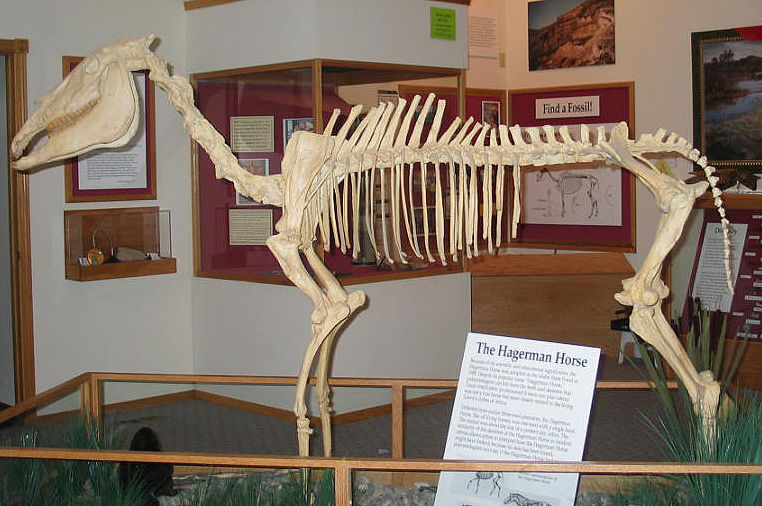- Hagerman Horse
Taxobox
name = Hagerman Horse
fossil_range = MiddlePliocene to LatePleistocene
status = Fossil
trend = down
status_system = iucn2.3

image_caption = Mounted skeleton of Hagerman Horse
image_width = 270px
regnum =Animal ia
phylum = Chordata
classis =Mammal ia
ordo =Perissodactyla
familia =Equidae
genus = "Equus"
species = †"E. simplicidens"
binomial = †"Equus simplicidens"The Hagerman horse ("Equus simplicidens"), also called the Hagerman zebra or the American zebra, was a
North American species of equid from the Pliocene period and the Pleistocene period. It was the ancestor of modern horses. Discovered in 1928 inHagerman, Idaho , it is believed to have been like theGrevy's zebra ofEast Africa .Classification
The Hagerman horse was given the scientific name of "Plesippus shoshonensis" in 1929 by a
Smithsonian paleontologist named James W. Gidley who led the initial excavations at Hagerman that same year.However further study by other paleontologists determined that fossils represented the oldest remains of the genus "Equus". It was then given the scientific name of "Equus simplicidens".Discovery
A cattle rancher named Elmer Cook discovered some fossil bones on this land in Hagerman, Idaho. In 1928, he showed them to Dr. H.T. Stearns of the
U.S. Geological Survey who then passed them on to Dr. James W. Gidley at theSmithsonian Institution . Identified as bones belonging to an extinct horse, the area where the fossils were discovered, calledthe Hagerman Horse Quarry , was excavated and three tons of specimens were sent back to the Smithsonian in Washington, D.C.Excavation of the fossils continued into the early 1930s.
The Hagerman Horse Quarry floor grew to convert|5000|sqft|m2 with a backwall convert|45|ft|m high. Ultimately five nearly complete skeletons, more than 100 skulls, and forty-eight lower jaws as well as numerous isolated bones were found. Some paleontologists believed that such a large amount of fossils from in one location was because of the quarry area being a watering hole at one point. The waterhole could have been where the bones of the Hagerman horses accumulated as injured, old, and ill animals, drawn to water, died there. It is now believed by most paleontologists that an entire herd of these animals probably drowned attempting to ford a flooded river and were swept away in the current and ended up buried in the soft sand at the bottom.Overview
The Hagerman horse first appeared about 3.5 million years ago. It was approximately 110-145 centimeters (43 to 57 inches) tall at the shoulder. It weighted between 110 and 385 kilograms (385 to 847 pounds). An average Hagerman Horse was about the same size as an
Arabian horse . It also was relatively stocky with a straight shoulder and thick neck, like a zebra, and short, narrow, donkey-like skulls. It is thought to have had stiff, upright manes, ropy tails, medium-sized ears, striped legs, and some striping on the back.The horse probably lived in grasslands and floodplains which is what Hagerman was like 3 million years ago. The horse went extinct about 10,000 years ago, the same time as many other species of the period.
Miscellaneous
The Hagerman horse is the state fossil of Idaho. [http://www.statefossils.com/id/id.html]
References
* [http://www.nps.gov/archive/hafo/quarry.htm The Horse Quarry]
* [http://www.nps.gov/archive/hafo/crittercorner/equus.htm Hagerman Fossil Beds' CRITTER CORNER - Hagerman "Horse - "Equus simplicidens"] Dr. Greg McDonald
* [http://www.talkorigins.org/faqs/horses/horse_evol.html TalkOrigins.org - Horse Evolution] Kathleen HuntFurther reading
*Boss, N.H. "Explorations for fossil horses in Idaho". Explorations and field work of the Smithsonian Institution in 1931. 1932.
*Gazin, C.L. "A study of the fossil horse remains from the upper Pliocene of Idaho". Proceedings from the United States National Museum 83(2,985): 281-320. 1936.
*MacFadden, Bruce J. "Fossil Horses. Systematics, Paleobiology and Evolution of the Family Equidae". Cambridge Univ. Press, 1992.
*McDonald, H. Gregory. "More than Just Horses, Rocks and Minerals", Sept./Oct. 1993. Vol. 68:322-326.
*Willoughby, David P. "The Empire of Equus". A.S. Barnes and Co. Inc., 1974
* [http://www.nps.gov/archive/hafo/castle_rocks_ea.pdf Castle Rock Ranch-Hagerman Horse Quarry Land Exchange Environmental Assessment]
Wikimedia Foundation. 2010.
